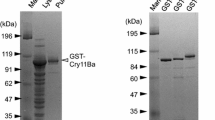Abstract
Integrated vector control is an effective and essential part of any successful vector control program. Increasing insecticide resistance requires strategies to prolong the use of highly effective vector control compounds. Synergistic activity between current effective pesticides is a powerful tool and is one such strategy. In the current study, Cyt1A from Bacillus thurigiensis subsp. israelensis and Bacillus sphaericus B101H5aH5b Bs were evaluated for the synergistic activity against B. sphaericus-resistant strains of Anopheles stephensi. The combinations of Cyt1A and B. sphaericus were found to act synergistically and were greatly enhanced at different ratios. A ratio of 1:4 of Cyt1A and Bs was 13,200-fold more toxic at LC90 against the Bs-resistant strains of A. stephensi than was Bs alone and this high level of activity resulted from synergism between Cyt1A toxin and Bs. Our results therefore suggest that Cyt1A may enhance toxicity by facilitating the binding or insertion of the binary toxins to the microvillar membrane.




Similar content being viewed by others
References
Abbot WS (1925) A method of computing the effectiveness of an insecticide. J Econ Ent 8:265–267
Aly C, Mulla MS, Federici BA (1989) Ingestion, dissolution, and proteolysis of the Bacillus sphaericus toxin by mosquito larvae. J Invertebr Pathol 53:12–20
Broadwell A, Baumann P (1986) Sporulation-associated activation of Bacillus sphaericus larvicide. Appl Environ Microbiol 52:758–764
Butko P, Huang FM, Pusztai-Carey M, Surewicz WK (1997) Interaction of the delta-endotoxin CytA from Bacillus thuringiensis var. israelensis with lipid membranes. Biochemist 36:12862–12868
Crickmore N, Bone EJ, Williams JA, Ellar DJ (1995) Contribution of the individual components of the d-endotoxin crystal to the mosquitocidal activity of Bacillus thuringiensis subsp. israelensis. FEMS Microbiol Lett 131:249–254
Crickmore N, Zeigler DR, Feitelson J, Schnepf E, Van Rie J, Lereclus D, Baum J, Dean DH (1998) Revision of the nomenclature for the Bacillus thuringiensis pesticidal crystal proteins. Microbiol Mol Bio Rev 62:807–813
Finney DJ (1971) Probit analysis, 3rd edn. Cambridge University Press, Cambridge
Georghiou GP, Wirth MC (1997) Influence of exposure to single versus multiple toxins of Bacillus thuringiensis subsp. israelensis on development of resistance in the mosquito Culex quinquefasciatus (Diptera: Culicidae). Appl Environ Microbiol 63:1095–1101
Ibarra JE, Federici BA (1986) Isolation of a relatively nontoxic 65-kilodalton protein inclusion from the parasporal body of Bacillusthuringiensis subsp. israelensis. J Bacteriol 165:527–533
Rao DR, Reuben R, Nagasampagi BA (1995) Development of combined use of neem (Azadirachta indica) and water management for the control of culicine mosquitoes in rice fields. Med Vet Entomol 9:25–33
Silva-Filha MH, Regis L, Nielsen-LeRoux C, Charles JF (1995) Low-level resistance to Bacillus sphaericus in a field-treated population of Culex quinquefasciatus (Diptera: Culicidae). J Econ Entomol 88:525–530
Sarup P, Dhingra S, Agarwal KN (1980) Newer dimensions for evaluating the synergistic effect of non-toxic chemicals in the mixed formulations against the adults of Cylas formicarius Fabricius. J Entl Res 4:1–14
Schnepf E, Crickmore N, Van Rie J, Lereclus D, Baum J, Feitelson J, Zeigler DR, Dean DH (1998) Bacillus thuringiensis and its pesticidal crystal proteins. Microbiol Mol Bio Rev 62:775–806
Thomas WE, Ellar DJ (1983) Mechanism of action of Bacillus thuringiensis var. israelensis insecticidal d-endotoxin. FEBS Lett 154:362–368
WHO (2005) Guidelines for laboratory and field testing of mosquito larvicides.World Health Organization, WHOCCDS/ WHOPES/GCDPP/2005.13
Wu D, Chang FN (1985) Synergism in mosquitocidal activity of 26 and 65 kDa proteins from Bacillus thuringiensis subsp. israelensis crystal. FEBS Lett 190:232–236
Wirth MC, Walton WE, Federici BA (2000) Cyt1A from Bacillus thuringiensis restores toxicity of Bacillus sphaericus against Culex quinquefasciatus (Diptera: Culicidae). J Med Entomol 37:401–407
Yuan Z, Zhang Y, Cai Q, Liu EY (2000) High-level field resistance to Bacillus sphaericus C3-41 in Culex quinquefasciatus from southern China. Biocontr Sci Technol 10:41–49
Acknowledgments
We thank Prof. Dr. M. Ramesh (of our Department of Zoology) for constant encouragement and critical evaluation of the manuscript.
Author information
Authors and Affiliations
Corresponding author
Rights and permissions
About this article
Cite this article
Chenniappan, K., Ayyadurai, N. Synergistic activity of Cyt1A from Bacillus thuringiensis subsp. israelensis with Bacillus sphaericus B101 H5a5b against Bacillus sphaericus B101 H5a5b-resistant strains of Anopheles stephensi Liston (Diptera: Culicidae). Parasitol Res 110, 381–388 (2012). https://doi.org/10.1007/s00436-011-2502-5
Received:
Accepted:
Published:
Issue Date:
DOI: https://doi.org/10.1007/s00436-011-2502-5




